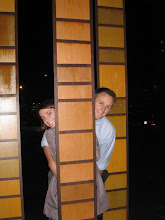After weeks of Saturdays spent baking on the beaches of New York we decided to switch things up this weekend and visit the Museum of Modern Art. Dominic was expecting some eccentric exhibits, but was surprised to find famous and current artwork drawing our attention. We spent the entire day wandering about.

It's the real deal people.

Dominic's favorite. We have the home made quilt to prove it (thank you Peg!).

There's an exhibition running now through November 7th called Talk to Me. If I were still a regular at the Social Media Club Seattle events I would totally cite my new-found knowledge of the communication between people and objects at our next mixer. I could have spent hours here.
Here's an introduction to the concept that we design based on meaning and no longer on function: "All objects contain information that goes well beyond their immediate use or appearance. In some cases, objects exist to provide us with access to complex systems and networks, behaving as gateways and interpreters. Whether openly and actively, or in subtle, subliminal ways, things talk to us, and designers help us develop and improvise the dialogue."
There were displays that you would expect: computers, video games, devices, etc... But what was neat about the exhibition was the fact that it also introduced us to projects in development today.
We learned, for example, about a way designers Emily Read and Chen Hsu are delivering vital information to the urban homeless. By reviving the centuries-old language of hobo code the homeless use a set of basic symbols to communicate everything from safe locations and free food to shelter and guard dogs all with a stick of sidewalk chalk. The code is published in each issue of The Pavement, a London-based magazine for the homeless. I'm not sure where they get the chalk.
Of course I got stuck for quite a while staring at this piece called "Sidetrack".

Four artists from the Copenhagen Institute of Interaction Design got together to create this turntable made from printer parts. The image shows how work-at-home professionals have trouble separating their home and work lives, and in particular how we spend most of our time at our desks and not in other parts of our homes. They reached this conclusion by putting sensors throughout the home that were connected to the rotating table. As the participant moved from room to room the table plotted the pattern, uncovering what the designers called 'pockets of time' devoted to various tasks. As it turns out, distractions were encouraged as healthy breaks (same goes for offices if you ask me). With each day recorded on a separate paper disk, professionals could start to learn from their own patterns.
Full disclosure: except for an early-morning jog to the recreation center, a mid-day walk to the park two blocks from our home, two trips to the kitchen and two more to the bathroom, I have stayed put in my corner office for approximately 10 hours now. Is that sad? What would my Sidetrack paper disk show?
We expended so much energy learning at the MoMA it was impossible to make it home without street-food sustenance for the ride:


2 comments:
That one reminds me of the spirograph art :) What's on that plate of food?
Lamb, chicken, rice, lettuce and lots of sauce. Healthy, right?
Post a Comment